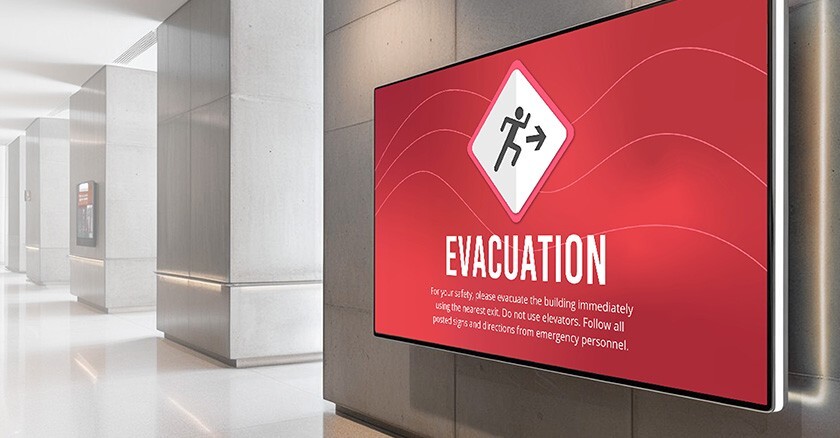
PHASE 1: PREVENT — BUILD A SAFER, MORE-INFORMED COMMUNITY
Prevention starts from within. It means ensuring government facilities are equipped with tools that promote situational awareness, workplace safety and employee readiness before emergencies even begin.
Internally, this can mean using digital signage to:
- Promote cybersecurity hygiene among staff
- Share public health reminders
- Display internal tip lines for suspicious behavior
- Regularly communicate evolving threat intelligence from regional and national agencies
Externally, prevention also supports community resilience. Use signage in public buildings like libraries, community centers and city hall, to share updates on weather alerts, vaccination availability and preparedness campaigns.
PHASE 2: PREPARE — PRACTICE NOW, SO YOU'RE READY LATER
Preparation hinges on clear communication and practiced protocols which include drills, tabletop exercises and clear communication protocols, ideally delivered via multimodal systems that don’t rely on a single method (visual, audio and text).
Together, these modalities create a redundant, multi-sensory safety net that reinforces muscle memory, mitigates environmental barriers, boosts compliance and adapts to evolving threats.
Use digital signage to amplify preparedness across agencies:
- Multimodal Simulations
Combine on-screen alerts, PA systems and mobile notifications to drill everything from severe weather lockdowns to IT system breaches. - Digital Emergency Hubs
Centralize floor maps, evacuation routes, emergency contacts and shelter information on displays in lobbies, break rooms and operations centers. - CAP-Integrated Practice Alerts
Connect your signage with Common Alert Protocol (CAP)-enabled systems to simulate real alert scenarios and train for coordinated response.
PHASE 3: RESPOND — REACH THE RIGHT PEOPLE INSTANTLY
The ability to deliver targeted, real-time messaging to both government workers and the public can mean the difference between chaos and coordinated action.
CAP, or Common Alert Protocol, is an XML-based system widely used by government, education, transportation, and corporate industries. With CAP integration, alerts can instantly override daily digital signage to broadcast emergency instructions in precise locations.
Respond with unified, targeted alerts:
- Instant Override for Unified Messaging
CAP-triggered alerts automatically replace all regular content on screens systemwide with emergency instructions. - Precise Targeting
Send alerts to specific buildings, wings or outdoor areas. Display floor-specific evacuation maps or shelter-in-place diagrams on screens in affected areas. - Clear Transitions to Recovery
“All Clear” Notifications: Replace emergency alerts with calming, green-banner updates to signal safety and share post-crisis instructions.
PHASE 4: RECOVER — REBUILD TRUST THROUGH COMMUNICATION
The recovery phase is a vital connection between crisis response and renewed stability. Clear communication is essential to rebuild trust and establish routines. Digital signage plays a key role in helping local government employees and citizens effectively coordinate actions after a crisis, reuniting families and restoring normalcy while delivering real-time updates that enhance clarity and accountability. Digital signage offers an agile way to coordinate post-crisis efforts.
Recover with coordinated communication:
- Public-Facing Updates
Use signage in city buildings to share hotline numbers, FAQs and next steps after a disaster or incident. - Internal Briefings
Rotate digital briefings and status updates in shared staff spaces to keep departments aligned during recovery. - Return to Normal Messaging
Transition signage back to standard content (meeting reminders, HR info and community events) to signal stability.
WRAPPING IT UP: PREPAREDNESS IS A PUBLIC SERVICE
Emergencies demand proactive, phased strategies, not reactive chaos. By aligning with the four phases of emergency management (prevent, prepare, respond, recover), local governments can transform vulnerability into resilience. Digital signage, integrated with CAP, empowers this transition:
- Prevent through proactive messaging.
- Prepare with CAP-automated drills.
- Respond decisively with unified, systemwide alerts.
- Recover by restoring trust with clear communication citywide.
NEXT STEPS:
Want to future-proof your city's emergency response strategy?
Schedule a call with our digital signage specialist to tailor a solution for your agency’s unique needs and protect your community from the inside out. Ask about our free government booklet, geared toward helping you simplify safety, communication and community engagement through digital signage.
Company bio:
Carousel is a leading digital signage platform that’s been keeping communities informed and safe for over 25 years. Designed for screens of all sizes, Carousel makes it easy for local governments to share critical information — quickly, clearly and reliably. You can reach the Carousel team at 612-261-1000 or visit Emergency Messaging with Carousel.







